Compiled by Geoff Goodall

Photo by Geoff Goodall
In early 1935 the company was renamed British Aircraft Manufacturing Co Ltd and stepped up production of the further refined
B.A. Swallow 2. Over a hundred BA Swallow 2s were built and a number came to Australia.
Meanwhile the British Klemm company's chief designer, the experienced George H. Handasyde had been designing a cabin touring monoplane designated B.K.1 Eagle. It had a superficial similarity to the Klemm L.32, but was an entirely new design. The prototype first flew at Hanworth in early 1934 and its clean lines and exceptional performance attracted much attention. The pilot had a central seat with a comfortable bench behind for two passengers plus room for baggage. The wings could be folded to save hangar space.
A new deluxe model named Eagle 2. was announced at the time of the name change to British Aircraft Manufacturing Co. Design changes included a deepened rear fuselage more rounded tailplane. The majority of Eagle IIs were built as B.A. Eagle 2s.
Total Eagle 2 production was 35 aircraft.
| .34 | Built by British Klemm Aeroplane Co Ltd at Hanworth Air Park, Feltham. Production B.K.1 Eagle Series 1 |
| 14.6.34 | Registered G-ACTR British Klemm Aeroplane Co Ltd at Hanworth |
| 21.10.34 | CofA issued |
| 10.34 | Ordered by Australian agents Adastra Airways Ltd, Mascot Aerodrome, Sydney |
| Shipped to Australia | |
| 12.34 | Assembled at Mascot by Adastra Airways |
| 14.12.34 | Registered VH-USI J. N. Laurie, Gloucester NSW |
| 14.9.36 | Change of ownership: Miss May Bradford, Mascot NSW (Married name: Mrs F. Shepherd) May Bradford was the first female to gain an Australian "A"commercial pilot licence and was employed by New England Airways as a ground maintenance engineer |
| 16.12.36 | Departed Brisbane as an entrant in the 3 day South Australian Centenary Air Race from Brisbane to Adelaide, pilot May Bradford. Race number 34, type listed as Klemm Eagle. Name The Golden Eagle |
| 24.1.37 | Takeoff collision, destroyed by fire at Sydney Airport, Mascot NSW May Bradford with two passengers had just lifted off the ground on takeoff when the Eagle's undercarriage struck the left wing of Desoutter VH-UEE which was taxying for departure. Both aircraft were conducting joy rides. The Desoutter pilot George Hoskins had stopped when he saw the Eagle approaching. After impact the Eagle struck the ground, overturned and burst into a fierce fire. All 3 on board died. The Desoutter was badly damaged but the occupants escaped injury |
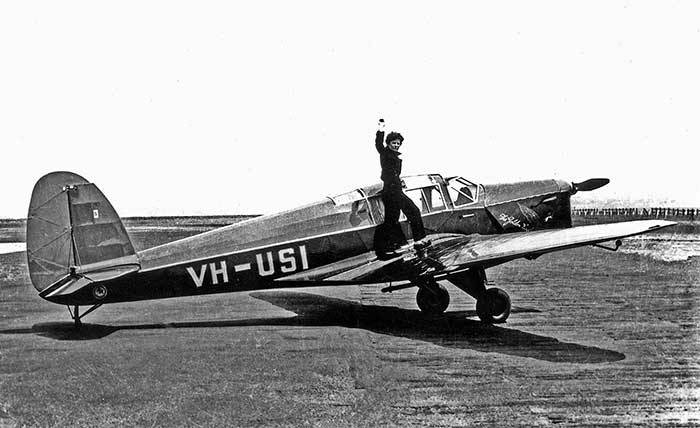
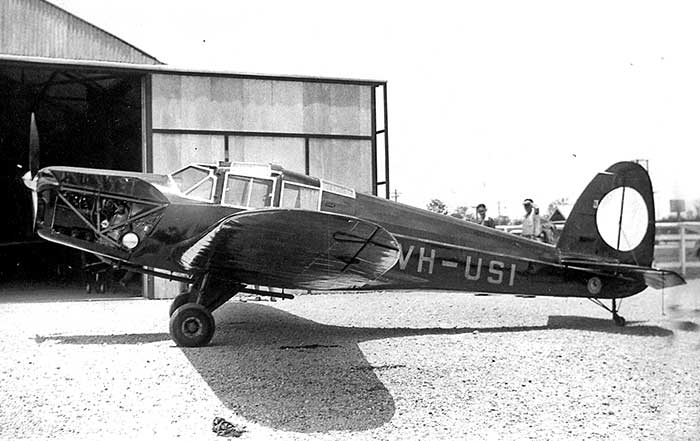
Reddall Collection via AHSA NSW Branch

| .34 | Built by British Klemm Aeroplane Co Ltd at Hanworth Air Park, Feltham. Production B.K.1 Eagle Series 2 |
| Although a B.K.2 model, this aircraft was completed with the deeper rear fuselage of the replacement design B.A. Eagle | |
| Ordered by Australian agents Adastra Airways Ltd, Mascot Aerodrome, Sydney | |
| Shipped to Australia | |
| Assembled by Adastra Airways at Sydney Airport, Mascot | |
| 29.1.35 | Registered VH-USP Adastra Airways Ltd, Mascot Aerodrome, Sydney |
| 29.1.35 | Australian CofA issued |
| 11.2.35 | Change of ownership: Walter M. "Pat" O'Hara, Malang, Java, Netherlands East Indies. Named Zeelandia. Walter O'Hara, a New Zealand citizen who had served in WWI as a army machine gunner, now lived at Dampit, Java where he managed a tea plantation. He had learnt to fly with the Aero Club of WA in Perth. |
| 9.35 | O'Hara was in Sydney where he had VH-USP modified with an extra fuel tank in the cabin.
He had an automatic pump fitted to replace the need to pump fuel with a
hand pump. The design and engineering drawings for the installation
were submitted to the Civil Aviation Branch |
| 10.35 | Sydney newspapers reported that a pilot would depart Sydney on 17 October on a solo flight to NZ. Because
he did not want to worry his aged mother, he did not release his name
to the press, which referred to him as a mysterious Pilot X. |
| 17.10.35 | Civil
Aviation Branch advised O'Hara that the Eagle's CofA was suspended,
based on an inspection of the cabin fuel tank installation ruling they
did not comply with regulations |
| 18.10.35 | O'Hara
departed Richmond RAAF Station near Sydney at 5.05am bound for NZ. He
reached the NZ coast near Auckland in rain and low cloud and approached
Mangere Aerodrome in the dark. |
| 18.10.35 | Landing at Mangere in the dark, he ran through a fence, damaging the undercarriage and coming to rest on the aircraft's belly |
| The flying time from Australia was 12 hours 47 minutes | |
| Pat
O'Hara was the first New Zealander to fly the Tasman Sea solo in either
direction. He was a guest of the Auckland Aero Club and treated as a
hero. | |
| 10.35 | Meanwhile
the Australian Civil Aviation Branch suspended his Australian Pilot
Licence for flying VH-USP while its CofA was suspended |
| O'Hara announced that he would make a goodwill tour of NZ when the aircraft was repaired. A campaign by Sydney businessmen commenced raising funds for him to make a special flight in 1936 from Australia to Netherlands East Indies and on to Japan to promote a trade fair with Japan, but O'Hara declined the offer | |
| 7.12.35 | Test flown Mangere, Auckland after repair |
| 26.12.35 | Pat
O'Hara departed Auckland in VH-USP on a NZ tour visiting many towns on
both islands, giving passenger flights and donating the funds to the NZ
Returned Soldiers Association. Aero Clubs made all the arrangements and
promoted his itinerary with civic receptions |
| 10.1.36 | Propeller tip damaged landing at Stoke, near Nelson. Repaired the same day by Cook Strait Airways. |
| 2.2.36 | O'Hara returned to Auckland in VH-USP |
| 19.2.36 | Struck-off Australian register |
| 14.3.36 | Registered ZK-AEA Walter M. O'Hara, Auckland NZ |
| ZK-AEA visited a flying
event at Rongotai Aerodrome, Wellington. A picture shows the Eagle in a
line of aircraft including a Waco, Moth Major, five Gipsy Moths and a
Rapide | |
| 4.36 | Dismantled at Auckland and crated for shipping to Sydney. Shipped from NZ to Sydney as cargo on MV Monowa |
| 5.5.36 | MV Monowa docked at Sydney carerying the Eagle and its owner. |
| 5.36 | Assembled
at Mascot. Press artciles reported that O'Hara said he would fly his NZ
registered
aircraft from Sydney on a leisurely return trip to Java. He intended to
travel via Perth and then up the West Australian coastline |
| 18.5.36 | ZK-AEA departed Mascot |
| 24.5.36 | Crashed, destroyed by fire, Cardogan Station, Eumungerie via Dubbo NSW. O'Hara was killed. O'Hara had been staying at Cardogan Station as a guest of Mr. R. E. Boyce. That morning he took off to fly to Dubbo to collect a hat before continuing to Cootamundra to have lunch with Mr. Arthur Butler of the Butler Air Transport Co at Cootamundra Aerodrome. After becoming airborne, O'Hara circled the Cardogan homestead at a low altitude waving to his hosts, when the aircraft stalled and dived into the ground |
| 23.7.36 | Struck-off NZ Civil Aircraft Register |
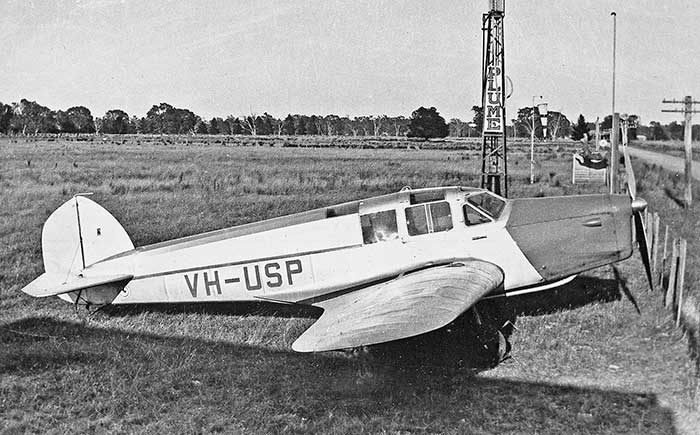
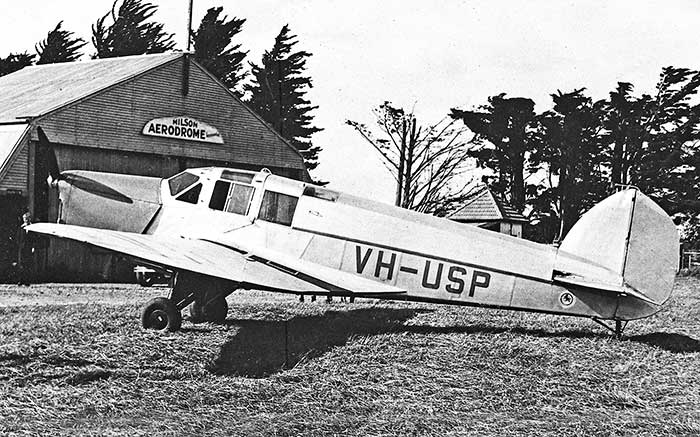

Crome Collection, National Library of Australia
| 34 | Built by British Klemm Aeroplane Co Ltd at Hanworth Air Park, Feltham. Production B.K.1 Eagle Series II. Completed with Gipsy Major No.5838 installed |
| Note: A.J. Jackson's authorative book series British Civil Aircraft Since 1919 states
that VH-UTI & VH-UTG were completed as B.A. Eagle 2s during the
reorganisation of British Klemm Aeroplane Co into British Aircraft
Manufacturing Co and launch of the deluxe BA Eagle 2. However all British and Australian official documentation at the time both were imported into Australia identifies them as B.K.1 Eagle 2s built by British Klemm Aeroplane Co Ltd. The current Australian civil register is of no help because the mandarins at CASA have taken it upon themselves to journalise VH-UTI's manufacturer as "Klemm Flugzeuge GmbH"ie. the German company, rather than the actual British manufacturer and designer. | |
| 7.12.34 | First test flight Feltham |
| 19.12.34 | British CofA issued VH-UTI Hannan Brothers, Adelaide, South Australia |
| 12.34 | Shipped to Australia |
| 1.35 | Assembled at Parafield Aerodrome, Adelaide by H.C.Miller of MacRobertson Miller Aviation Co |
| 3.2.35 | Test flown Parafield after assembly, pilot H.C.Miller |
| 2.35 | Change of ownership: Percy Knapman, Adelaide SA |
| 18.4.35 | Australian CofA issued |
| 18.4.35 | Registered VH-UTI Percy Knapman, Adelaide SA |
| 29.1.36 | Damaged landing, pilot Knapman |
| 22.10.36 | Damaged during forced landing near Two Wells SA due engine trouble, pilot Knapman |
| 16.12.36 | Departed Brisbane as an entrant in the 3 day South Australian Centenary Air Race from Brisbane to Adelaide, pilot Knapman. Race number 29, type listed as Klemm Eagle. Name Spirit of Fun |
| 18.12.36 | Completed the Air Race at Parafield, total flying time 7 hrs 52 mins |
| 1.9.41 | CofA expired. Retired in a hangar at Parafield due to the war situation. When RAAF required the hangar space, VH-UTI was dismantled and stored in an Adelaide brick kiln. |
| 9.42 | DCA
Parafield memo: overhaul has been completed but Knapman will not test
fly or use the aircraft because of the current wartime requirement that
he paint it in camouflage |
| 2.44 | DCA Parafield memo: UTI is dismantled for inspection, Knapman wishes to sell the aircraft to Mr. Dunn, Dunlite Electrical Co Ltd, Adelaide |
| 3.3.44 | CofA renewed at Parafield |
| 3.3.44 | Change of ownership: Lloyd B. Dunn, Adelaide SA |
| 3.44 | Based
at Port Pirie SA. Mr. Dunn flies the aircraft to towns and station
properties on Eyre Peninsular in western SA for his electrical business |
| Serviced by Spencers Gulf Aero Club, Whyalla SA | |
| 45-46 | Leased to John P. Kellow & Dick Edwards, Whyalla SA trading as Gulf Aviation Services Flown by Kellow on charter work from Whyalla. Jack Kellow later wrote of this Eagle: "I flew 80 hours in this very efficient machine" |
| 7.45 | Kellow, then a pilot
instructor with Spencers Gulf Aero Club wrote to DCA with a proposal to
install a stretcher in VH-UTI in order to use it on Flying Doctor Service contract work. No indication if the modification was carried out |
| 2.46 | VH-UTI flown by Kellow with Edwards as passenger from Whyalla to Geelong Vic to inspect two
Fairchild 24s VH-ABZ & VH-ACV being reconditioned ex RAAF by Brown &
Dureau Ltd at Belmont Common airfield. The partners purchased both Fairchilds for Gulf Aviation Services. |
| 7.48 | DCA
Parafield memo: Dunn bases VH-UTI at Parafield, uses it mostly for
flights to Eyre Peninsular where he does electrical work at
agricultural properties |
| 1.4.49 | Change of ownership: Glen M. McWilliam, McWilliam Wines, Hanwood Winery, Griffith NSW |
| 11.5.49 |
Delivered Parafield-Griffith by Adelaide instructor Reg Ellis accompanied by purchaser Glen McWilliam. On arrival Griffith, Ellis gave McWilliam conversion training on the type. |
| McWilliam later wrote: "The
Eagle's aerodynamics were superb. I could cruise with three on board at
1109-115mph on little over 5 gallons per hour. Being keen on aerial
photography I bought a F24 aerial camera from military disposals. Some
Griffith Aero Club mates not long back from the war had aerial survey
knowledge and were keen to have a go at serious survey work. I
had a hole cut in the Eagle and mounted the camera initially with a
home-made wire grid, later automatic line overlap timing gear, and we
were in business.
Some business arrangement had to be made between myself and the aero
club members' expertise. After a while I offered to sell the Eagle to
the Club at a price that covered my capital expenses to date. The Club
had little money and terms were installments when they could. Our
main customer was the Water Conservation and Irrigation Commission. We
did aerial surveys of water acreages used for rice growing in the
Murrumbidgee Irrigation Area (MIA) which proved quite lucrative for the
Club, using our volunteer labour. There we probably several reasons why
our irrigation surveys were terminated, one being our heads got a
little big and we upped the price a bit too much. Anyway, a good time
was had by all." |
|
| 3.1.51 | CofA expired. Not renewed |
| 6.8.51 | Struck-off Civil Register during DCA's 1951 Census of unairworthy aircraft |
| 21.11.51 | Restored to Register: Griffith Aero Club, Griffith NSW |
| 21.11.51 | CofA renewed |
| 16.3.52 | Change of ownership: Murrumbidgee Irrigation Area Aeronautical & Scientific Association, Griffith NSW Continued to be operated by Griffith Aero Club with the aero club's name painted on the tail |
| 2.1.53 | Undercarriage damaged while taxying at Temora NSW, pilot R.Morrison |
| Retired for maintenance at Jack Hodder's hangar at Parkes NSW | |
| 20.7.61 | Struck-off Register as Withdrawn from Service |
| 61-70 | VH-UTI stored dismantled in Jack Hodder's hangar at Parkes, "Griffith Aero Club" painted on tail |
| Acquired by Jack D. Hodder, Parkes NSW. He operated an aircraft maintenance business in the Parkes hangar and owned airworthy BA Eagle 2 VH-ACN | |
| 10.69 | Included in Jack Hodder's sale of his airworthy BA Eagle 2 VH-ACN to Colin Monk, Sydney NSW |
| c72 | Acquired by Nick and Greg Challinor, Burleigh Heads Qld The brothers were vintage aircraft enthusiasts who had seen VH-UTI while refuelling their Tiger Moth at Parkes circa 1969 and decided they could restore it to airworthy |
| Moved by road to Burleigh Heads where restoration of the wooden airframe commenced. | |
|
This was the first rebuilding project of the Challinor brothers, later joined by their father, to
become the maintenance business MothCair, respected for high quality restorations of
vintage aircraft at Murwillumbah Airfield. Graham Orphan later wrote of the brothers' first project in Classic Wings Down Under magazine: "The first problem with the Eagle was encountered as soon as the brothers got the big monoplane home. In order to put it into their workshop they first had to take it into a neighbour's back yard, remove the fence, demolish one of the walls of their flat and then install the aircraft. Nick still praises their tolerant landlady who lived in the flat above in close range of the ever present sounds of power tools and dope fumes. The Eagle is anything but the ideal choice for a first-time restoration project. It is rare and drawings are unavailable. Of all wooden construction, it is considderably more complicated than its De Havilland or Miles contemporaries. It also boasts a manually retractable undercarriage and folding wings. With all this in mind, Nick and Greg set about effecting the rebuild of VH-UTI with great enthusiasm. Progress was slow but steady whilst the brothers gained the necessary skills if splicing, ply skinning, engine plumbing and fabric work." | |
| 18.4.78 | VH-UTI noted at Murwillumbah, restoration completed, painted yellow and silver. It had made fast taxying trials on the airfield |
| 8.11.79 | Official first test flight at Murwillumbah, pilot Nick Challimoir |
| 10.11.79 | Ferried
from Murwillumbah to Griffith NSW for inspection by a licenced aircraft
maintenance engineer experienced in vintage aircraft construction with approval to recommend a Certificate of Airworthiness |
| 16.11.79 | Restored to Register VH-UTI Nick P. Challinor, Murwillumbah NSW |
| 11.79 | CofA renewed at Griffith |
| 11.12.79 | Flew home Griffith-Murwillumbah |
| .84 | Sold to Joseph G. Drage/ Drage's Historical Aircraft Museum, Wodonga Vic |
| 9.84 | Among the aircraft collection at Joe Drage's property near Wodonga Vic |
| 4.10.84 | Register change of ownership from Nick Challinor to City of Wangaratta, Wangaratta Vic |
| 1.85 | Drage collection was displayed in a new purpose-built large hangar at Wangaratta Airport Vic under new name Drage Airworld.
Interstate bus terminal and restaurant included in the museum
buildings. Ownership of the Drage aircraft collection was taken over by the City of
Wangaratta. |
| 27.1.85 | One of 8 airworthy aircraft of the Drage collection flown from Wodonga to Wangaratta |
| 8.96 | Auction announced for disposal of 10 selected aircraft of the Airworld Collection, which has been forced to rationalise to continue. Among the ten aircraft was Eagle VH-UTI offered in airworthy condition. |
| 19.11.96 | Sold at auction of selected Airworld aircraft to Robert (Roy) Fox, Sydney NSW (Fox owned a number of vintage aircraft, including Klemm L-25D VH-UUR) |
| 29.8.99 | Damaged in accident at Sydney-Bankstown Airport |
| 4.01 | visited fly-in at Parkes NSW, yellow and silver |
| 4.13 | visited fly-in at Echuca Vic, same yellow and silver scheme |
| Based at Roy Fox's private airfield at his property The Missions 1937, near Wisemans Ferry NSW | |
| Current |
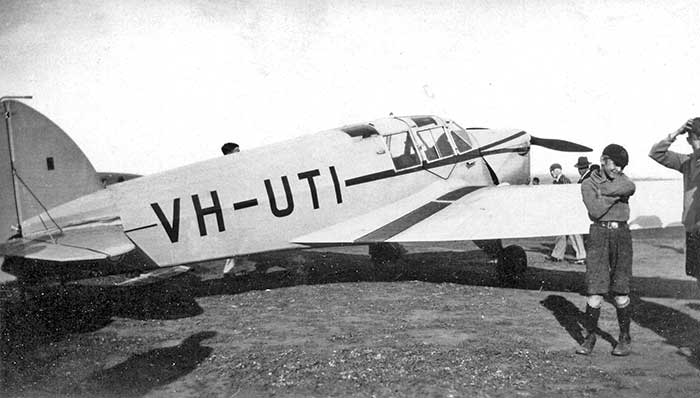
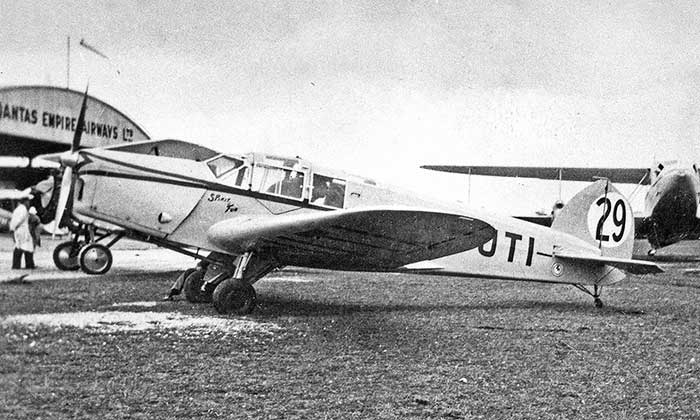
Neil Follett collection
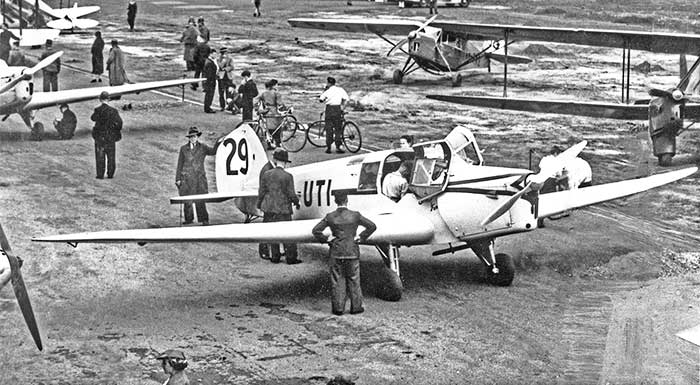
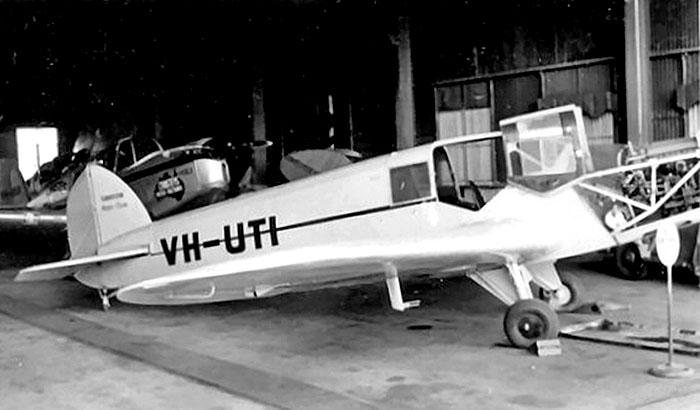
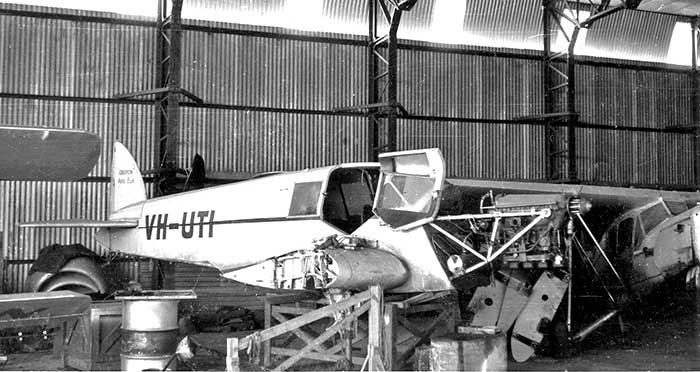
Geoff Goodall collection
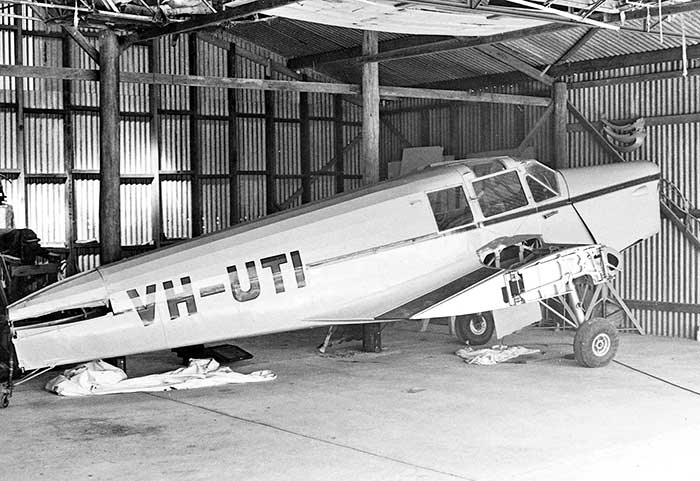
Photo by Mike Vincent
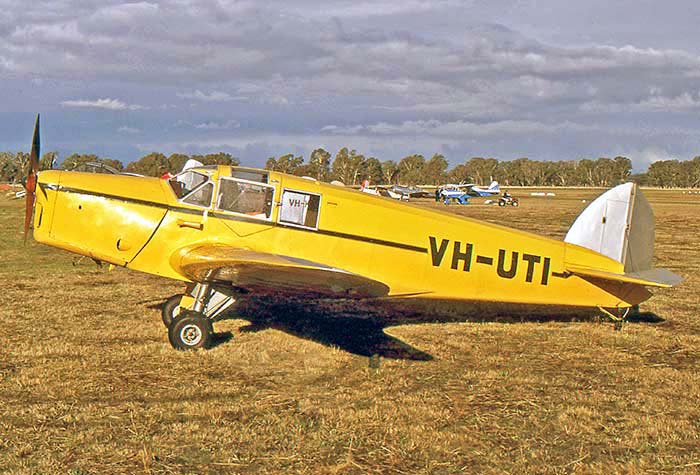
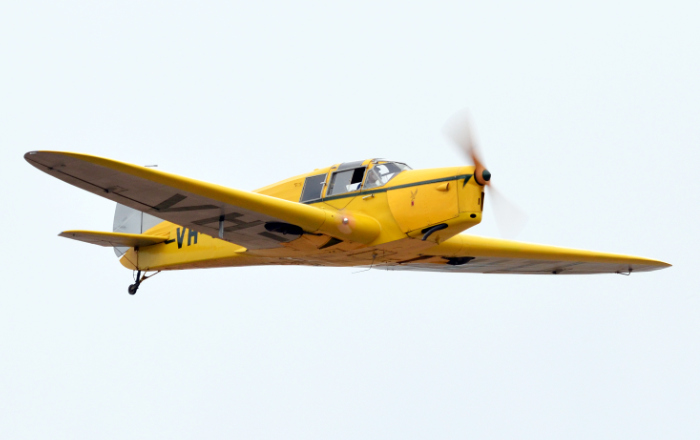
VH-UTI performs a flypast with gear retracted
at a fly-in at Echuca Vic April
2013.
Photo by Roland Jahne
| .34 | Built by British Klemm Aeroplane Co Ltd at Hanworth Air Park, Feltham, Middlesex Production B.K.1 Eagle Series 2 |
| Note: A.J. Jackson's authorative book series British Civil Aircraft Since 1919 states
that VH-UTI & VH-UTG were completed as B.A. Eagle IIs during the
reorganisation of British Klemm Aeroplane Co into British Aircraft
Manufacturing Co and launch of the deluxe BA Eagle 2. However all British and Australian official documentation at the time both were imported identifies them as B.K.1 Eagle IIs built by British Klemm Aeroplane Co Ltd | |
| 28.2.35 | British CofA issued VH-UTG: Adastra Airways Ltd, Mascot Aerodrome, Sydney |
| Shipped to Australia | |
| 20.4.35 | Test flight Mascot after assembly by Adastra Airways, pilot Adastra Managing Director Frank Follett |
| 24.4.35 | Registered VH-UTG Adastra Airways Ltd, Mascot Aerodrome, Sydney |
| Fitted at Mascot with an Eagle camera and equipment for vertical photography for aerial survey contracts | |
| 7.35 | Conducting a large scale aerial mapping contract of northern and western South Australia for the SA State Government |
| 13.7.35 | Damaged when undercarriage collapsed landing at Oodnadatta SA. Pilot R. T. Cropley and the camera operator were unhurt |
| 7.10.35 | Damaged when rolled into a drain during landing Beltana SA. Pilot Norman A Adam and two passengers were unhurt |
| 36 | Adastra
were negotiating the sale of VH-UTG and had ordered a replcement Eagle
VH-UUY assembled at Mascot in April 1936. The camera gear and fittings
from VH-UTG were installed in VH-UUY |
| 16.5.36 | Change of ownership: Robert T. Vincent, Geelong Vic, later Broadford Vic Vincent also owned Klemm L-25 VH-USH, which he had used for his business, but had been retired the previous year |
| 19.5.36 | Flown Mascot-Geelong on delivery by R.T. Vincent |
| Based
Belmont Common airfield Geelong. Often flown by Charlie Pratt of Pratt
Flying School, Geelong and the flying school staff pilot Perce Colman. | |
| 16.12.36 | Departed Brisbane as an entrant in the 3 day South Australian Centenary Air Race from Brisbane to Adelaide. Entered by R.T.Vincent with nominated pilot Charles D. Pratt. Race number 35 |
| 18.12.36 | Vincent and Pratt completed the Air Race at Parafield, total flying time 6 hrs 35 mins |
| 7.38 | CofA renewal overhaul at Essendon by Victorian & Interstate Airways |
| By 1939 Vincent had enlisted in RAAF and was a flying instructor at RAAF Point Cook Vic. On 29.11.39 Flying Officer Robert Trevor Vincent and his pupil were killed when DH.60 Moth A7-62 crashed after takeoff Point Cook. Vincent's funeral with full air force honours was held on 22.12.39 at Highton Cemetry, Geelong. Klemm Eagle VH-UTG circled above, flown by Perce Coleman | |
| 6.40 | Estate of the late R.T.Vincent wish to sell the aircraft. VIA at Essendon are acting as sale agents |
| 25.7.40 | Change of ownership: Aircrafts Pty Ltd, Archerfield Airport, Brisbane Qld APL used the Eagle to maintain scheduled air services after the loss of APL aircraft which were impressed by the Government for RAAF earlier that year. The Eagle was sold in 1944 after DCA arranged for RAAF to release two DH.84 Dragons to APL |
| 6.5.44 | Change of ownership: Queensland Flying Training School, Archerfield Qld (a partnership between H.J.Hughes and H.F.Bremerman) |
| 16.3.46 | Change of name: Queensland Flying Services, Archerfield Qld (same partners) |
| 4.7.47 | Change of ownership: Allan C. Cameron & Derek Scott, trading as Camsco, Tenterfield NSW The partners operated a charter business with Tiger Moth VH-BCI and Butler BAT VH-ARG |
| 17.10.47 | Minor damage due undercarriage collapse at Toowoomba Qld |
| 29.11.47 | Damaged, port undercarriage collapsed while taxying at Tamworth NSW |
| Not repaired, stored damaged in hangar at Tamworth aerodrome | |
| .48 | Directors
of East-West Airlines had decided to diversify the company's airline
activities by commencing crop dusting operations with Tiger Moths
during 1947. In late 1948 the Board accepted an offer from Camsco to
sell EWA their three aircraft: - Tiger Moth VH-BCI airworthy - Butler BAT VH-ARG dismantled for overhaul - Klemm Eagle damaged, stored at Tamworth. The Tiger joined the EWA agricultural fleet and it was envisaged that the Eagle would be used for charter work in the Tamworth region, particularly carrying stock buyers and rural agents |
| 30.11.48 | Change of ownership: East-West Airlines Ltd, Tamworth NSW |
| The Eagle was repaired by EWA
Chief Engineer Ted Walsh and his staff on a spare-time basis, priority
given to maintaining the airline's Avro Anson and Lockheed Hudson fleet | |
| 9.6.50 | CofA renewed at Tamworth |
| 14.7.50 | local test flight Tamworth, pilot Arch Smith, EWA Chief Pilot |
| 15.7.50 | local flying Tamworth by Arch Smith, endorsing First Officer Jim Packer on the Eagle |
| 17.7.50 | first EWA charter flown by Arch Smith, Maules Creek-Tamworth with two passengers |
| 28.7.50 | Crashed during forced landing in trees near Moree NSW Propeller broke away in flight due to the propeller shaft fracturing at the forward end of the crankcase. The aircraft's wings were torn away during forced landing in trees surrounded by flood waters |
| EWA Chief Pilot Arch Smith was flying the Eagle on flood relief at
Moree. He was operating from a road near the town carrying supplies and
food to drop to properties isolated by flood waters. Captain Smith
later wrote in his book East West Eagles: "I had just levelled off when there was a wrenching snap and the propeller flew off and curved away to my left like a huge boomerang. I immediately cut the switches to stop the racing engine, turned off the fuel, pushed the nose down to maintain airspeed and turned north to what I hoped was shallower water. I called out to Kyrle Grace (a local farmer who was observer/dropper) to throw out the remaining food parcels - they were stacked behind us and likely to crush us with the impact of a forced landing. I flew the Eagle with my right hand while holding the cockpit door open with my left and Kyrle got rid of the parcels mighty fast...............I was holding an airspeed of 75 miles per hour as I held off a few feet above the floodwaters and aimed between two trees. We smacked into the two trees simultaneously with both wings" Both men sustained minor injuries when their seat harnesses were torn away from their anchors. The trees sheared off the outer wings on each side but the cabin was intact. They stayed in the cabin overnight with water just below seat level and next morning built a signal fire. They were located by a searching EWA Anson and were eventually rescued by Army Ducks from Moree. | |
| 11.50 | East West Airlines advise DCA that VH-UTG will not be rebuilt |
| 27.11.50 | Struck-off Register |
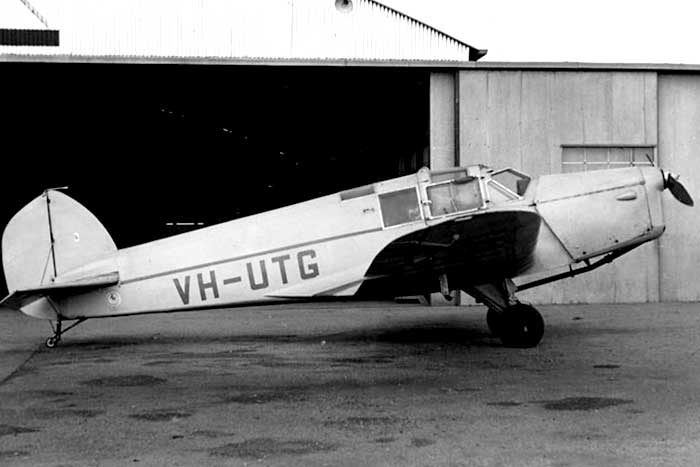
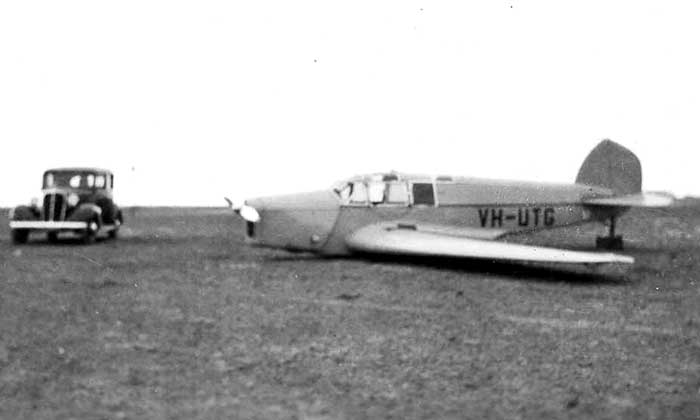
Photo: Robert Millburn collection
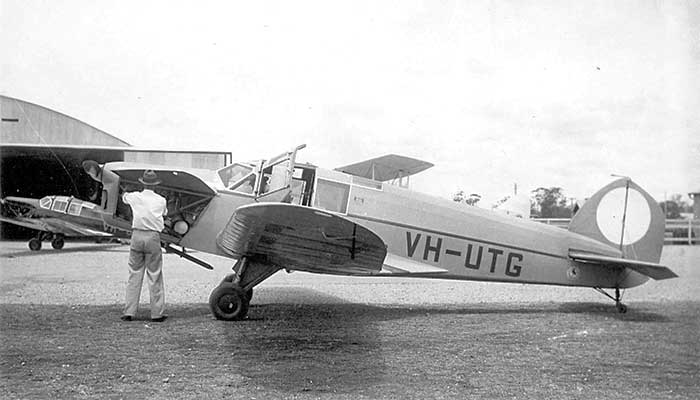
Behind is May Bradford's Eagle VH-USI which was also in the race. Frank Walters collection
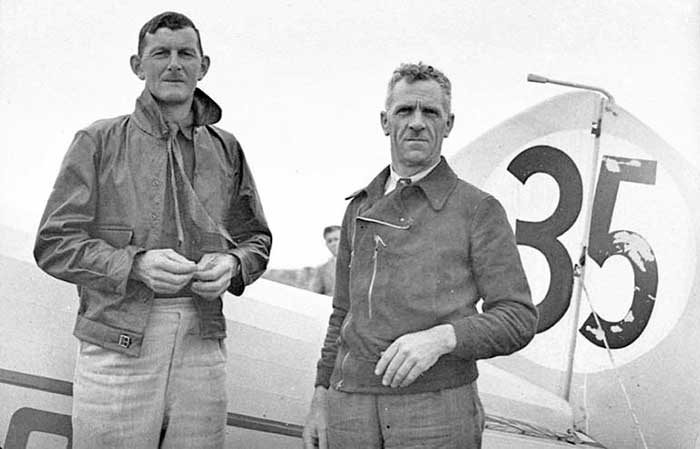
Hugell collection via Kevin O'Reilly
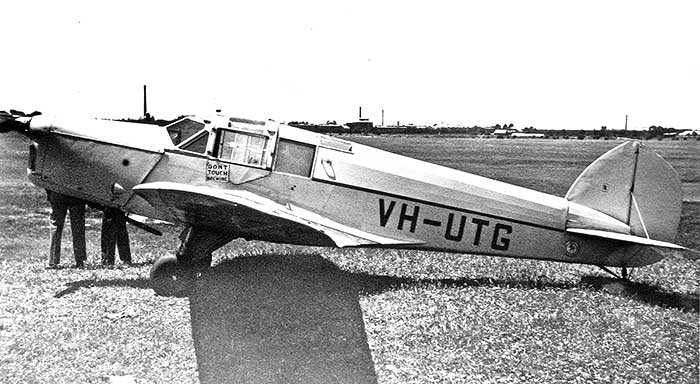
Photo by C.D.Pratt via Kevin O'Reilly collection
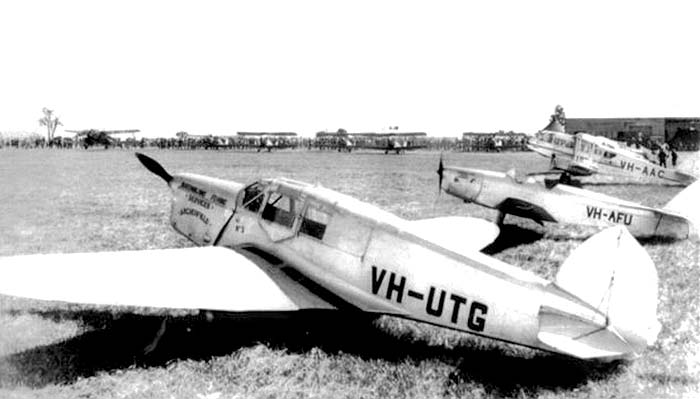
Photo: Geoff Goodall collection
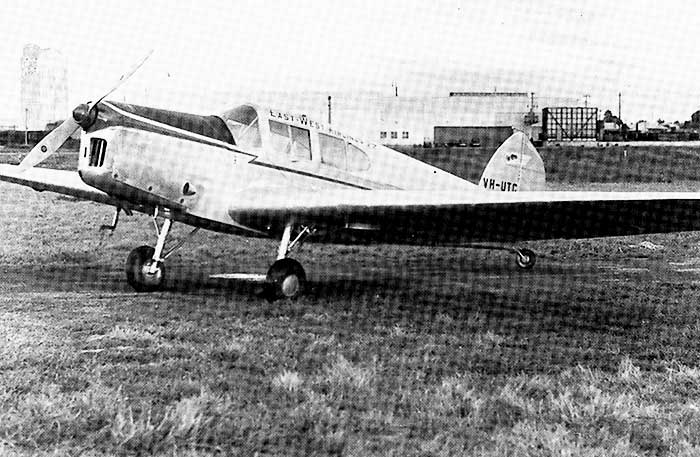
Tamworth NSW 14 July 1950. Photo by Arch Smith
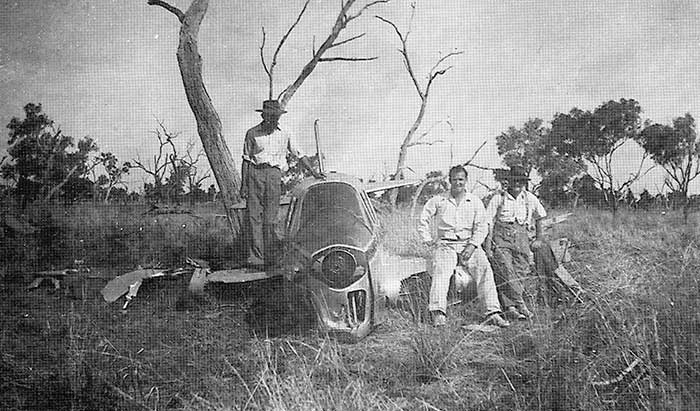
This picture was taken when the wreck was collected by EWA after the floods . Pilot Arch Smith centre
| .35 | Built by British Aircraft Manufacturing Co Ltd at Hanworth Air Park, Feltham, Middlesex Production B.A.Eagle Series II |
| 28.9.35 | British CofA issued: VH-UUY Adastra Airways Ltd, Mascot Aerodrome, Sydney NSW |
| 30.10.35 | Log book: First flight Hanworth |
| Shipped to Australia | |
| 4.36 | Assembled at Mascot by Adastra Airways, airframe time 4 hrs 15 mins |
| 16.4.36 | Registered VH-UUY Adastra Airways Ltd, Mascot Aerodrome, Sydney NSW |
| 16.4.36 | Australian CofA issued at Mascot |
| Adastra
Airways were expanding their aerial vertical photographic survey business.
VH-UUY was fitted with the Eagle camera and equipment previously installed in their Eagle VH-UTG | |
| 8-11.36 | Based at Cairns Qld on a photographic survey contract. Maintenance problems with the undercarriage retraction mechanism due to salt water corrosion. Cairns airfield was situated on tidal mud flats which flooded at high tides |
| 11.5.37 | Inspection report at Mascot. Airframe time 505 hrs |
| 8.37 | UUY returned to Cairns, to be based there several months on survey flown by Norm Rodoni |
| 9.8.37 | Forced landing on a beach 8 miles north of Cairns due engine failure, pilot Rodoni. Aircraft undamaged and at low tide it was towed behind a vehicle to Cairns. Engine replaced |
| 4.38 | Based Coffs Harbour NSW on survey flying |
| 6.38 | Shipped
from Sydney to New Guinea to conduct a photographic survey for Papuan
Apinaipi Petroleum Co Ltd. Accompanied by pilot Norm Rodoni and camera
operator Lavender |
| 7.38 | Arrived at Port Moresby as cargo on board coastal steamer Montoro |
| Flew aerial mapping sorties over Papuan Apinaipi Petroleum's oil search permit areas | |
| Shipped back to Sydney | |
| 24.3.39 | Inspection report at Mascot. Airframe time 1042 hrs |
| 9.39 | Adastra
advise DCA that VH-UUY has not flown survey for the past 12 months as
is being held as reserve aircraft for the company's Sydney-Bega airline
service currently operated by DH.90 Dragonfly VH-AAD |
| 28.7.40 | Government subsidy for the Sydney-Bega service was withdrawn due wartime restrictions. Adastra replaced VH-AAD on the scheduled service with the smaller BA Eagle VH-UUY |
| 22.8.40 | Forced landing on a beach at Shell Harbour NSW due engine failure. No airframe damage. UUY was being used on Adastra Airways' Sydney-Bega scheduled airline service |
| 9.40 | Retired, parked in Adastra hangar at Mascot being advertised for sale |
| 21.11.41 | Adastra Airways wrote to DCA requesting approval under wartime civil aviation regulations to sell VH-UUY
to Mr. E. E. McIllree, Sydney. : "……the
machine has been surplus to our requirements for more than 12 months,
during which time it has not flown. It was offered to the Air Board who
refused it on the grounds that it was not suitable for their work. This
Co. requires the funds from the sale to re-invest in workshop plant and
equipment to carry out contracts for the Ministry of Munitions - we
have on hand at present work for the Vickers M.G. Project - and plant
is becoming available but must be accepted by us immediately". DCA cabled approval of the sale |
| 25.11.41 | Change of ownership: Eric Edward Mcillree, Sydney NSW |
| 1.42 | Sqn
Ldr E. H. Loneragan requests DCA approval for a fuel ration to fly
VH-UUY from Camden to Mudgee while he is on military leave, to check
his business interests. He is Managing Director of Jas Loneragan
(Mudgee) Ltd. Loneragan advises he is teaching Mr. McIllree to fly to enable him to gain his pilot licence |
| 11.43 | CofA renewal overhaul at Mascot |
| 24.11.43 | Damaged landing Mascot after test flight by Peter J. Loneragan following the CofA inspection. Undercarriage and propeller damaged. Quickly repaired |
| 24.2.44 | Undercarriage collapsed landing at Mudgee, pilot P. J. Loneragan. |
| 21.4.44 | Change of ownership: Jas Loneragan (Mudgee) Co Pty Ltd, Mudgee NSW. |
| 14.11.44 | Annual CofA renewal at Mascot |
| Used for Loneragan family private and company flying for the next 20 years. During this period E. H. "Tim" Loneragan owned Ansons VH-BLG & BLD, Percival Gull VH-BQA, Ryan STM VH-AHC and Beech 17 VH-BBL, followed later by Pipers Apaches and Aztecs. Other members the Loneragan family in the Mudgee district also owned a number of private aircraft | |
| The Loneragan family
businesses included a large Mudgee department store, farming,
agricultural investments, bakeries, flour mills, agents for White Heather whiskey, a rural finance
company, and building the first motels west of Sydney. He dealt in war
surplus equipment in New Guinea. In 1946 he founded Aircraft Disposals Co, Mudgee in partnership with E. E. McIllree to convert RAAF disposals Avro Ansons to 7 seat airliners for resale on the civil market. Over 40 Ansons were acquired. | |
| 51-59 | VH-UUY was based at Gulgong NSW flown by Tim's brother Bryan Loneragan |
| 1.12.64 | Change of ownership: Ian G. Hope, Oberon NSW, later Bathurst NSW.. Based at Bathurst aerodrome |
| noted parked outside at Bathurst NSW, all silver finish. | |
| 12.7.65 | Damaged when landed at Bathurst with undercarriage only partly extended. Pilot I. G. Hope |
| 28.11.68 | Struck-off Register as withdrawn from service |
| Became derelict in the weather at Bathurst aerodrome. Owner declined offers to sell, saying he planned to restore it himself | |
| Finally acquired in dilapidated condition by Nick and Greg Challinor, Murwillumbah NSW. The fuselage back was broken, pieces of wood had fallen from the derelict airframe and were scattered on the ground and metal fittings were dug out of the ground where they had settled. A collection of parts was salvaged to assist the Challinors' on-going restoration of Eagle VH-UTI. When VH-UTI was restored and sold to Joe Drage, and later Roy Fox, the remaining parts collection from VH-UUY was included in each sale |
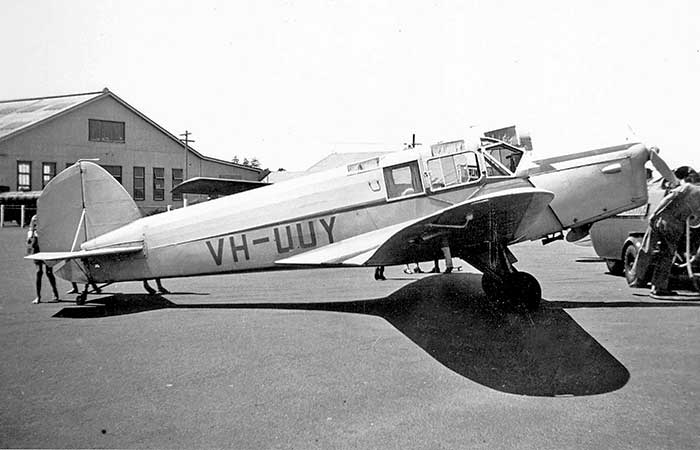
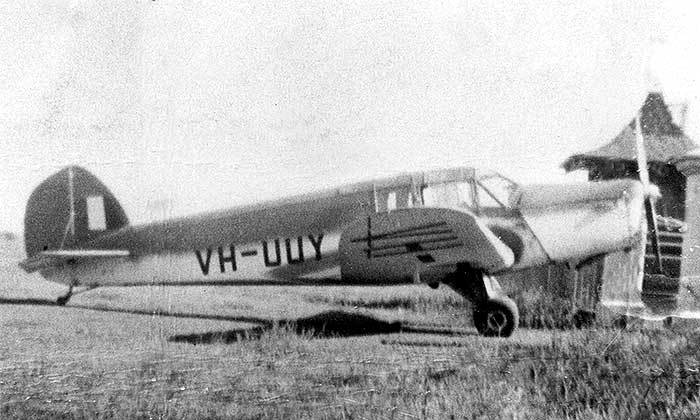
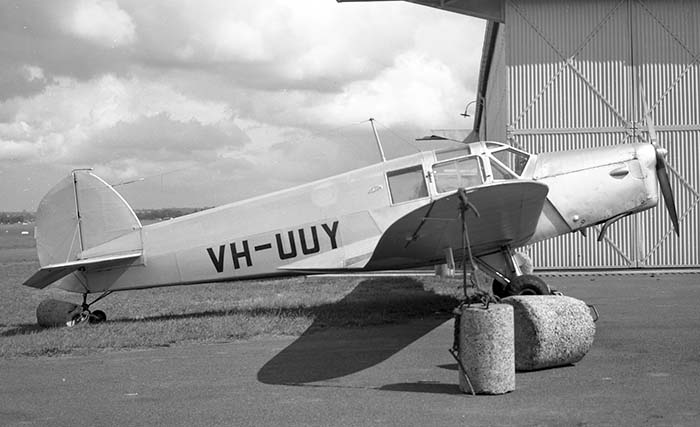
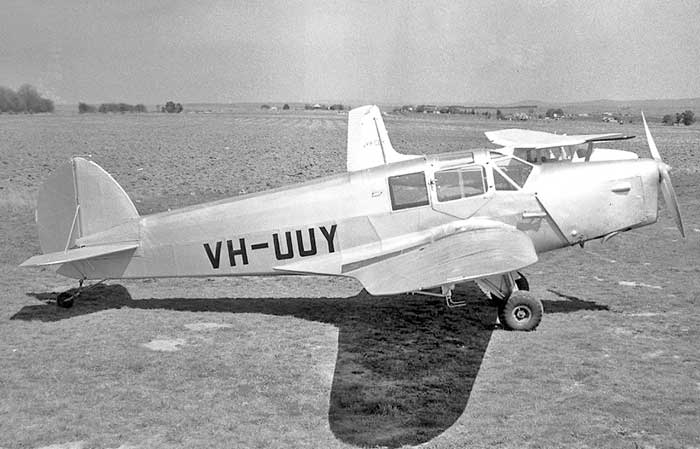
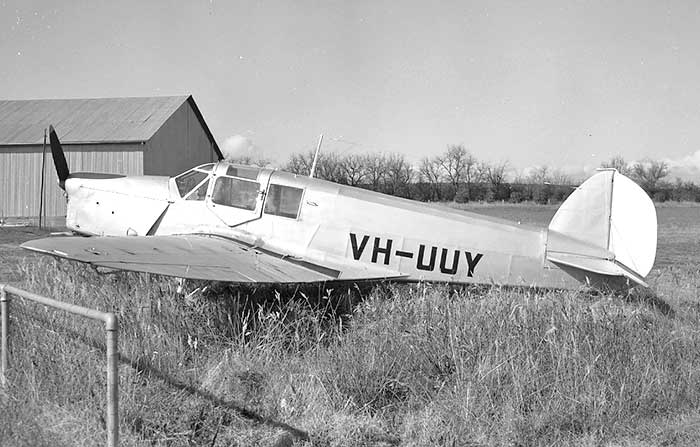
Photo by Geoff Goodall
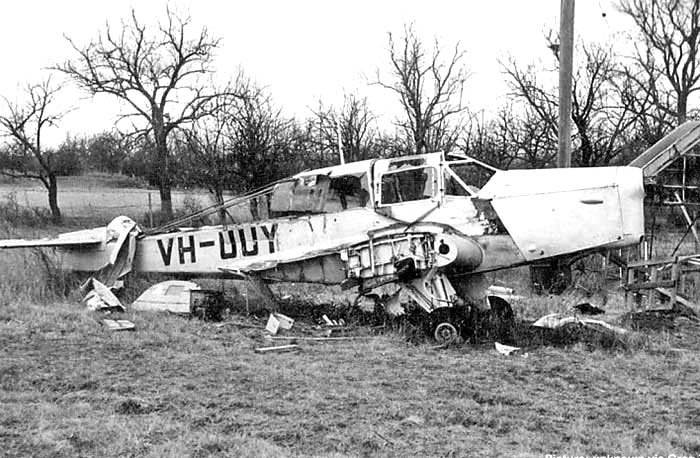
Both photos: Greg Thom collection
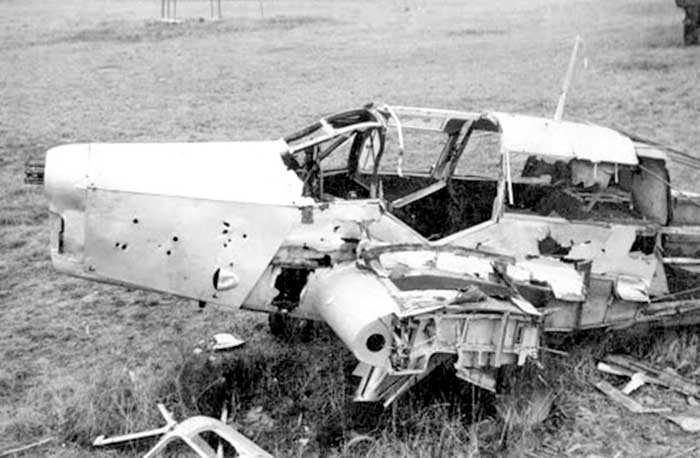
| .37 | Built by British Aircraft Manufacturing Co Ltd at Hanworth Air Park, Feltham, Middlesex Production B.A.Eagle Series II |
| Ordered by H.O. Hamilton specifying fixed undercarriage, the only Eagle so modified | |
| 7.37 | Registered G-AFAX British Aircraft Manufacturing Co Ltd at Hanworth Aerodrome, Feltham. |
| 5.7.37 | First flight Hanworth |
| 6.8.37 | CofA issued |
| 8.37 | Change of ownership: Hector Oliver Hamilton, Shoreham |
| 28.8.37 | G-AFAX competed in Folkestone Trophy Air Race, race number 14. |
| 6.39 | Change of ownership: John D. Hodder, Kanbauk, Burma Jack Hodder was an Australian diesel engineer and commercial pilot from Kings Cross, Sydney. He had been based in Burma since 1937 as a Chief Pilot and senior engineer for the Tavoy Tin Dredging Corporation's mine at Kanbauk, 300 miles south of Rangoon |
| G-AFAX was shipped to Burma in wooden crates, assembled by Hodder as his personal aircraft | |
| In
July 1937 Hodder in Burma had written to relatives of missing airman
Sir Charles Kingsford Smith to report he had visited Aye Island, Burma
to inspect an aircraft wheel
found by local fishermen. He was certain it was from the missing
Lockheed Altair VH-USB "Lady Southern Cross". He had located broken
tree tops and small pieces of metal on the island close to where the
wheel was found in the water. He had been investigating local plane crash reports because the Altair's copilot Tommy Pethybridge had been a friend when Hodder had earlier been doing his pilot training at the Kingsford Smith Flying School at Mascot. Hodder's personal attempts over the following year to find more wreckage were unsuccessful | |
| 30.10.39 | Hodder departed Burma on a holiday flight home to Sydney |
| 11.11.39 | G-AFAX arrived at Darwin from Koepang, Timor |
| 12.11.39 | Hodder departed Darwin for
Broome WA. He will fly down the WA coast to visit Perth on his way to
Sydney because he wanted to see the west. |
| 13.11.39 | Minor damage to undercarriage during landing at Roebourne WA. Repaired by Hodder |
| 17.11.39 | Arrived Maylands Aerodrome Perth WA. "I am just going home from work. Some men use bicycles to go home. I am using my plane." Mr. John Hodder, aged 42, told reporters on arrival at Perth |
| 18.12.39 | Hodder arrived at Brisbane in G-AFAX on the last leg of his flight to Sydney |
| 16.2.40 | Australian Registration application: John D. Hodder, Sydney NSW |
| 16.2.40 | Aircraft inspection report at Mascot Aerodrome, Sydney. Airframe time 286 hrs |
| 1.3.40 | Registered VH-ACN John D. Hodder, Sydney NSW |
| 1.3.40 | Australian CofA issued |
| Jack
Hodder was a
commercial pilot with aircraft engineering endorsements. He took a
variety of flying and maintenance jobs. He purchased DH.60G Moth VH-ULE
in August 1940, followed by other aircraft, but retained ownership of
this BA Eagle for almost 30 years | |
| 29.12.40 | Undercarriage damaged landing Mascot on an area of sandy surface. Pilot Hodder, charter flight with two passengers, no injuries |
| 14.2.41 | Aircraft inspection report at Mascot. Airframe time 445 hrs |
| 4.42 | DCA memo: VH-ACN has been painted in camouflage in accordance with DCA wartime regulations |
| 12.4.42 | Hodder
flew the Eagle from Sydney to Melbourne. He was commencing employment
with Ansett Airways at Essendon Aerodrome. Because RAAF had taken over
Essendon hangarage, he based VH-ACN at Coode Island Aerodrome near Port
Melbourne |
| CofA
maintained during war years and Hodder was issued petrol ration
vouchers by DCA No doubt due to his essential work as a licenced ground
engineer maintaining the Ansett Airways Lockheed 10 Electras used on
theSydney-Townsville US courier service | |
| 27.8.45 | Undercarriage damaged at Mascot, pilot Hodder. Local flight with one passenger |
| 1.2.46 | Change of ownership: Sydney Austin, "Wambianna" via Trangie NSW |
| 20.10.49 | Change of ownership: John D. Hodder, Royal Hotel, Casino NSW, later Sydney NSW, Parkes NSW |
| 51 | Jack Hodder established an
aircraft maintenance business at Parkes Aerodrome NSW. He leased one of
the RAAF wartime Bellman hangars and was widely used by country
aircraft owners and aerial agricultural operators. By the 1960s Hodder was in demand for maintenance on vintage aircraft types and his Parkes hangar was always packed with interesting aircraft, including another Eagle, the retired VH-UTI. |
| 16.6.55 | Struck-off Register, withdrawn from service |
| 12.8.55 | Restored to Register: John D. Hodder, P.O.Box 166, Parkes NSW |
| Jack Hodder based VH-ACN at his Parkes hangar, also later acquiring PA-22 TriPacer VH-PHJ | |
| 29.5.64 | Change of ownership: R. K. Larkins, "Inverleith", Tottenham NSW |
| 13.10.64 | Change of ownership: John D. Hodder, Parkes NSW |
| 20.10.69 | Change of ownership: Colin Monk, Sydney NSW The dismantled Klemm Eagle VH-UTI was included in the purchase. It had been stored in Jack Hodder's hangar at Parkes for the previous ten years |
| 18.6.72 | VH-ACN noted at Camden in the Air Gold Coast hangar with Cliff Douglas' other aircraft |
| 9.72 | Sold to Cliff Douglas, Coolanagatta Qld |
| 18.5.73 | Civil Register Change of ownership: Cliff C. Douglas, Tallebudgera Qld |
| 16.5.74 | Struck-off Register |
| 15.8.74 | noted at Coolangatta Airport, in hangar |
| Cliff Douglas established Chewing Gum Field Air Museum at Tallebudgera Qld, where VH-ACN was among aircraft displayed inside a hangar transported from Eagle Farm Airport, Brisbane | |
| 18.4.78 | noted inside the display hangar at CGFAM |
| c86 | Acquired from Cliff Douglas by British vintage aviation ethusiast Geoff Green, whose day job was a Boeing 747 Captain with Cathay Pacific Airways based at Hong Kong |
| Shipped to UK | |
| 27.10.87 | Restored to British Register G-AFAX J. Geoffrey Green, Bath, later Chertsey |
| 1.89 | VH-ACN stored dismanted in a workshop at Denford Manor, Hungerford, England, red & cream |
| 29.3.06 | Change of ownership: Fundacion Infante De Orleans, Cuatro Vientos Airport, Madrid, Spain |
| 3.9.06 | G-AFAX flying at a Fundacion Infante De Orleans event at Cuatro Vientos, Madrid, also 1.10.06 |
| 10.6.08 | Struck-off British Register |
| Currently displayed at Fundacion Infante De Orleans hangars, Cuatro Vientos. | |
| The
FIO aviation historical association acquired the Eagle because of the
type's significance: in 1935 famous Spanish aviator Juan Ignatio Pombo
flew a BA Eagle 2 from Spain to Gabon, Africa then across the South Atlantic Ocean to Brazil where he crashed at
Natal. A replacement Eagle 2
was shipped to him, in which he continued his long-distance flight to Mexico City. |
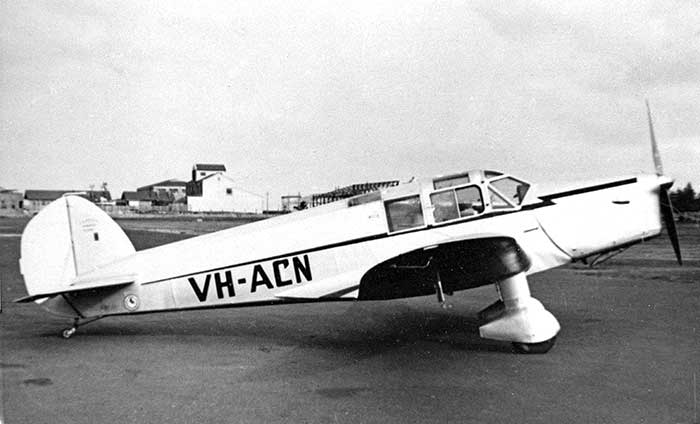
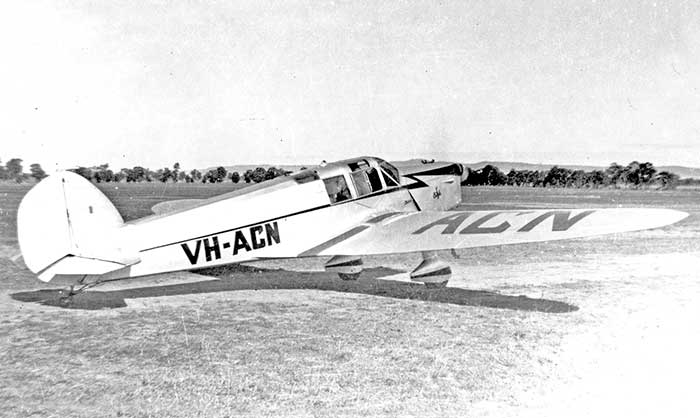

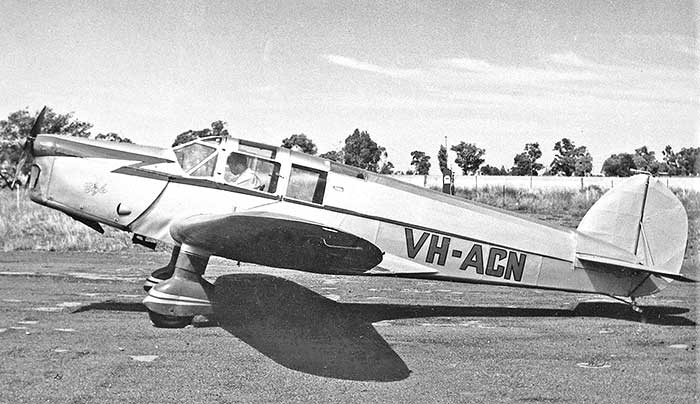
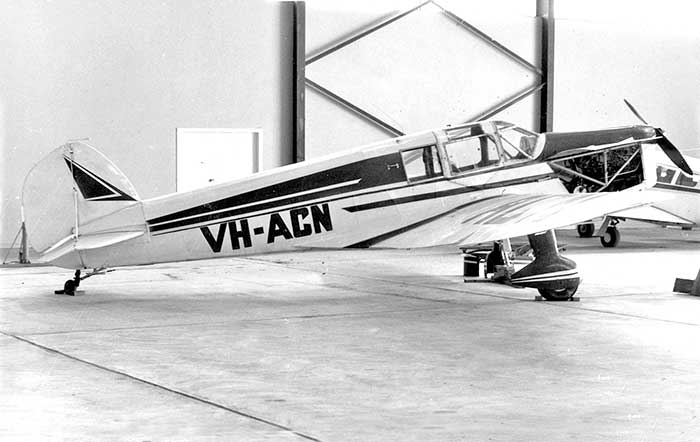
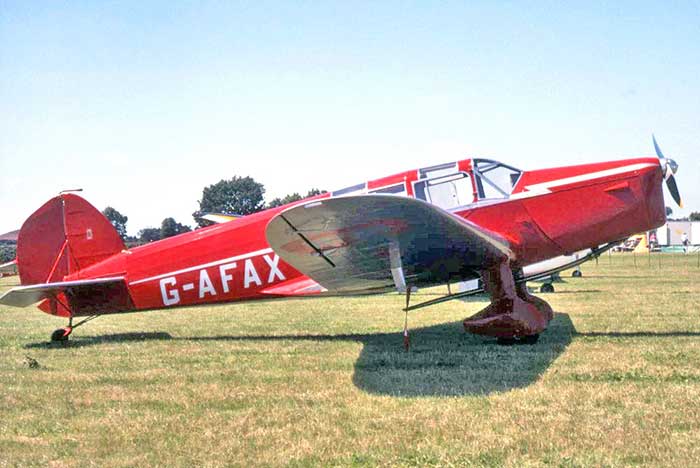
Photo by Dave Welch
G-ACVU c/n 30 was completed by British Klemm for Shaw as a special racing version which included an extra fuel tank in the cabin.
As race No.47, with name The Spirit of Wm. Shaw and Co Ltd painted on the cowlings, Shaw was third last to be flagged off at Mildenhall at 6.43am on 20 October 1934. Later that first day he made an unplanned brief stop near a village in Spain. Shaw was making good time as he reached Bushire, Iraq where the undercarriage was badly damaged on landing, forcing him to retire from the race.
The aircraft was returned to England and repaired.
- DCA Aircraft Files, National Archives of Australia
- British Civil Aircraft Register site: g-info
- British Civil Aircraft Since 1919, A. J. Jackson, Putnam
- British Klemm Eagle: Aviation Historical Society of NZ Journal, May 1969 & July 1969
- Wings of Gold - How the Aeroplane Developed New Guinea, James Sinclair, Pacific Publications, Sydney 1978
- East West Eagles, The Story of East West Airlines, Archie J. Smith, Robert Brown & Assoc, Brisbane, 1989
- Wing Tips - The Royal Aero Club of SA, Book 1 1919-1941, Mike Milln, Avonmore Books, 2011
- The Centenary Air Race, Aviation Heritage Vol 24 Nos. 1 & 2, Aviation Historical Society of Australia
- Rag & Tube magazine, Antique Aeroplane Association of Australia, quarterly from 1975: Eagle reports
- Adastra Airways history site: http://www.adastron.com/adastra/default.htm
- Roy Fox site: http://www.themissions1937.com.au